Comments / Questions (13)
![]() Heike wrote:
Heike wrote:
Wird das mit 4,5er Nadeln nicht unglaublich locker ?! Fabel ist ausgelegt für 2,5 bis 3,0.
01.11.2024 - 12:08DROPS Design answered:
Liebe Heike, so braucht man die Textur für die Decke, beachten Sie, daß Ihre Maschenprobe stimmt, und passen Sie die Nadel Nummer an, wenn nötig ist. Viel Spaß beim Stricken!
01.11.2024 - 16:52
![]() KONIK wrote:
KONIK wrote:
Bonjour, je désire réaliser ce magnifique plaid mais plus grand , en 140 x 168 cm , je suis en train de faire mes calculs pour commander les fils. Je ne trouve pas les fils numéro 159 et 903 , par quels fils toujours en Drops Fabel puis-je les remplacer ? Je voudrais avoir à la fin la même belle harmonie de couleurs. Merci d'avance pour votre réponse .
26.11.2023 - 15:58DROPS Design answered:
Bonjour Mme Konik, ces couleurs ne sont effectivement plus disponibles, n'hésitez pas à demander conseil à votre magasin, on saura vous conseiller, même par mail ou téléphone, les couleurs assorties. Bon tricot!
27.11.2023 - 09:40
![]() Sylke Loose wrote:
Sylke Loose wrote:
Hallöchen! Wenn ich die Decke an der längs und an der quer Seite jeweils um eine Quadrat Reihe vergrößer, wieviel Garn brauche ich dann jeweils mehr?
22.06.2021 - 07:29DROPS Design answered:
Liebe Frau Loose, wir haben die Decke leider nicht mehr, am besten stricken Sie einen Quadrat, so können Sie die neue Garnmenge leichter kalkulieren. Ihr DROPS Laden kann Ihnen auch gerne damit - auch telefonisch oder per E-Mail weiterhelfen. Viel Spaß beim stricken!
22.06.2021 - 08:14
![]() Ingunn Holden Bergh wrote:
Ingunn Holden Bergh wrote:
Jeg vil gjerne kjøpe garnet og strikke teppet Sunset Mountains, men lurer på om teppet finnes i andre fargekombinasjoner (mener jeg har sett det en gang det dukket opp på Facebook). Jeg ser bare en fargekombinasjon på dette bildet, Modell fa-417.
28.03.2020 - 11:43DROPS Design answered:
Hej Ingunn, Her kan du se alle vores tepper med domino interiør - domino
31.03.2020 - 11:31
![]() Eileen Ainsworth wrote:
Eileen Ainsworth wrote:
Am knitting the sunset mountains, but am confused. Is each ' square ' made up of rd triangles ? Am I really silly ?
05.11.2019 - 14:45DROPS Design answered:
Dear Mrs Ainsworth, each square consist of a square also called domino - see this video. Happy knitting!
05.11.2019 - 14:58
![]() Pauline Baltazar wrote:
Pauline Baltazar wrote:
Je suis en train de terminer ce très beau modèle qui reçoit beaucoup de compliments pour ses couleurs. J'ai rencontré toutefois un problème: pour faire un carré il faut 1/3 de pelote de chacune des deux couleurs (mesure 28x28 respectée). Or vous indiquez 200g de 904 (lavande) qui doit être utilisé pour 13 carrés. Je n'ai pu réaliser que 12 carrés avec le coloris 904 (4 pelotes= 12 carrés): il me manque un carré n°6. Il m'aurait donc fallu 250g de 904 et non 200g. Cordialement.
12.08.2019 - 15:13DROPS Design answered:
Bonjour Mme Baltazar, et merci. Avez-vous bien la bonne tension, soit 20 m x 38 rangs point mousse = 10 x 10 cm? Merci!
12.08.2019 - 16:13
![]() Amanda wrote:
Amanda wrote:
I would like to make this, but I noticed that wool warehouse does not have picnic in stock right now. Can I use substitute picnic with Bourgogne or sunset (which I have at home)?
05.05.2019 - 16:00DROPS Design answered:
Dear Amanda, sure, you can - may be sunset will be a bit better choice as it has more contrasting colours. Happy knitting!
05.05.2019 - 18:56
![]() Anna wrote:
Anna wrote:
É possibile lavorare con i ferri dritti anziché con i circolari? Grazie
01.05.2019 - 16:32DROPS Design answered:
Buongiorno Anna, il modello in questione è una coperta lavorata in quadrati che poi vengono uniti. Può lavorarli con i ferri dritti. Buon lavoro!
01.05.2019 - 16:34
![]() Marta wrote:
Marta wrote:
È possibile lavorare il quadrato domino a maglia rasata anziché a maglia legaccio?
04.02.2019 - 12:08DROPS Design answered:
Buongiorno Marta, per cambiare la lavorazione del quadrato domino deve tenere presente che i gettati vengono lavorati sul rovescio del lavoro e che il campione e le misure finali risulteranno diverse da quelle riportate. Buon lavoro!
04.02.2019 - 15:46
![]() Cornelia Wankerl wrote:
Cornelia Wankerl wrote:
Liebes DROPS-Team, ich suchte eben vergebens nach der Anleitung Fabel-415 von der Herbst-Winter-Kollektion; war mir sehr sicher, dass diese mit abgestimmt wurde. Habe ich irgend eine Möglichkeit, an die Anleitung dieses wunderschönen Modelles zu kommen? Liebe Grüße Cornelia
23.08.2018 - 21:56
Sunset Mountains#sunsetmountainsblanket |
|
 |
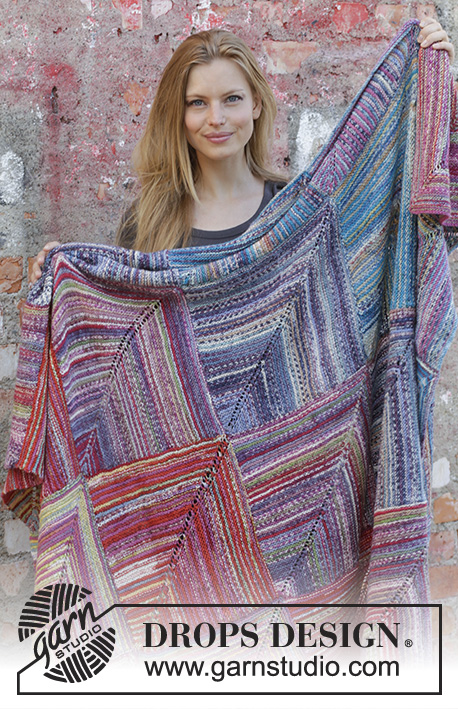 |
Knitted blanket with domino squares, stripes and garter stitch in DROPS Fabel.
DROPS 195-37 |
|
|
EXPLANATIONS FOR THE PATTERN: ------------------------------------------------------- RIDGE/GARTER STITCH (worked back and forth): 1 ridge = Knit 2 rows. ------------------------------------------------------- START THE PIECE HERE: ------------------------------------------------------- BLANKET - SHORT OVERVIEW OF THE PIECE: The blanket consists of 20 domino squares in 7 different colour combinations. All the squares are worked in 1 strand and you change colour on each RIDGE – read description above. Do not cut the strand when changing colour on the square - allow it to be carried forward along the side of the piece. The squares are sewn together to finish SQUARE 1: Cast on 5 stitches with circular needle size 4.5 mm and lavender (colour 904). Insert 1 marker thread in the middle stitch. And work domino square as follows: ROW 1 (= wrong side): Knit. ROW 2 (= right side): Knit as far as the stitch with the marker thread, 1 yarn over, knit 1 (stitch with marker thread), 1 yarn over, knit to end of row. Change to pink dream (colour 161). ROW 3 (= wrong side): Knit. ROW 4 (= right side): Knit as far as the stitch with the marker thread, 1 yarn over, knit 1 (stitch with marker thread), 1 yarn over, knit to end of row. Change to lavender (colour 904). Work ROWS 1-4 onwards. REMEMBER THE KNITTING TENSION! Work like this until you have worked 54 ridges (113 stitches on the row), loosely cast off and leave a length of one strand approx. 70 cm if possible (this is then used for assembly). The square measures approx. 28 x 28 cm. Work 1 more square = a total of 2 squares. SQUARE 2: The square is worked as SQUARE 1, but cast on and start with yellow/pink (colour 903), and change to pink dream (colour 161). Work a total of 2 squares. SQUARE 3: The square is worked as SQUARE 1, but cast on and start with pink dream (colour 161), and change to red chili (colour 159). Work a total of 3 squares. SQUARE 4: The square is worked as SQUARE 1, but cast on and start with picnic (colour 911), and change to lavender (colour 904). Work a total of 4 squares. SQUARE 5: The square is worked as SQUARE 1, but cast on and start with lavender (colour 904), and change to turquoise/blue (colour 522). Work a total of 4 squares. SQUARE 6: The square is worked as SQUARE 1, but cast on and start with blue sea (colour 162), and change to lavender (colour 904). Work a total of 3 squares. SQUARE 7: The square is worked as SQUARE 1, but cast on and start with shoreline (colour 914), and change to pink dream (colour 161). Work a total of 2 squares. ASSEMBLY: Lay the squares in the order shown in the sketch; make sure that all the squares lie the same way. Use the strand ends to sew the squares together or use a strand from one of the other balls. Sew in the outermost loop of the outermost stitch/ridge so that the seams are flat. |
|

|
|
Have you finished this pattern?Tag your pictures with #dropspattern #sunsetmountainsblanket or submit them to the #dropsfan gallery. Do you need help with this pattern?You'll find 11 tutorial videos, a Comments/Questions area and more by visiting the pattern on garnstudio.com. © 1982-2025 DROPS Design A/S. We reserve all rights. This document, including all its sub-sections, has copyrights. Read more about what you can do with our patterns at the bottom of each pattern on our site. |
|











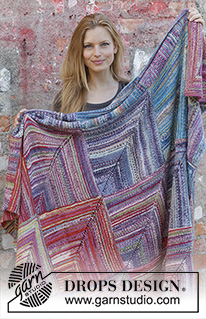
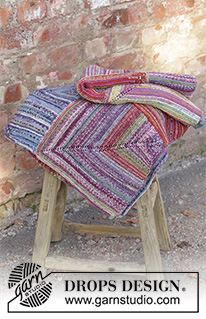
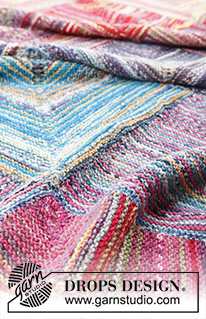












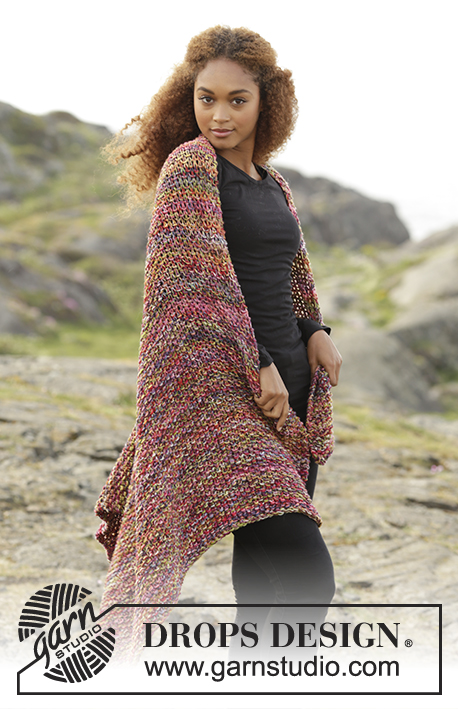
























Post a comment to pattern DROPS 195-37
We would love to hear what you have to say about this pattern!
If you want to leave a question, please make sure you select the correct category in the form below, to speed up the answering process. Required fields are marked *.